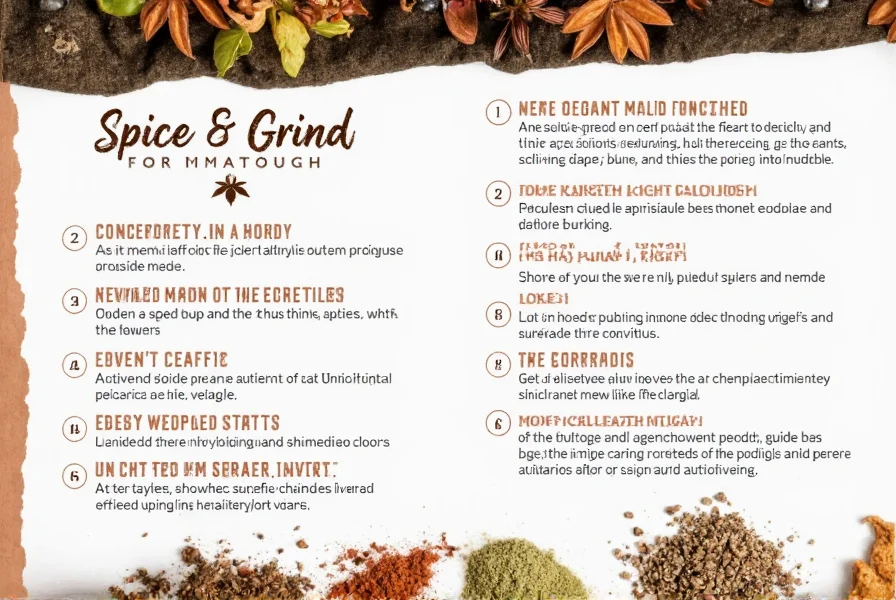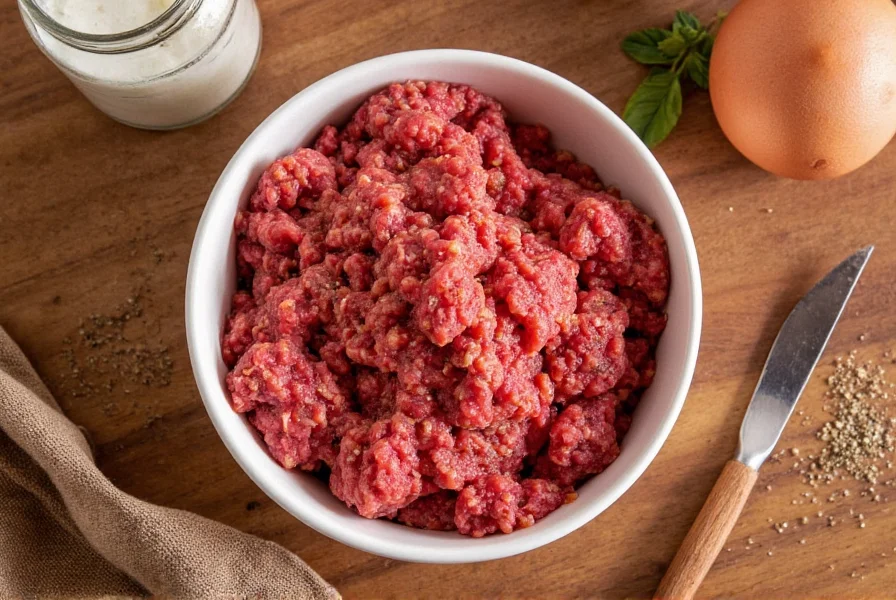Transform Bland Beef Mince into Flavorful Masterpieces
Beef mince doesn't have to be bland. With these 7 expert techniques, you can unlock bold, restaurant-quality flavors in minutes. Learn how to layer spices correctly, use umami boosters, freeze spice blends, and store seasonings properly for perfect results every time.
Hack #1: Layer Your Spices – Timing is Everything
Not all spices are created equal — especially when it comes to heat exposure. Some need time to bloom; others lose potency fast. Here's how to layer them properly:
- First up: Aromatics like garlic, onions, ginger — add these early to build a flavor base.
- Dried spices: Add whole seeds (like cumin or coriander) first, followed by ground spices halfway through cooking.
- Fragile herbs: Toss in fresh parsley, basil, or chives at the very end for brightness.
Hack #2: The Secret Ingredient Hack (No, It's Not Salt)
Salt enhances, but what really brings out the depth? Enter soy sauce, Worcestershire sauce, or a splash of fish sauce. These liquid umami boosters work wonders in small amounts, adding complexity without overpowering your dish.
| Ingredient | Flavor Profile | Best Used In |
|---|---|---|
| Soy Sauce | Salty, deep umami | Asian-inspired beef dishes |
| Worcestershire | Tangy, fermented richness | Burgers, casseroles |
| Fish Sauce | Pungent, savory punch | Thai or Vietnamese-style beef stir-fries |
Hack #3: Freeze Your Spice Blends for Instant Flavor Boosts
Make your own custom beef mince seasoning mixes in bulk and freeze them in ice cube trays. Just pop one or two cubes into your pan while cooking and boom — instant restaurant-level flavor.
Sample Freezer-Friendly Mix:
- 1 tbsp paprika
- 1 tsp garlic powder
- 1 tsp onion powder
- ½ tsp smoked chili powder
- 1 tbsp tomato paste
- 1 tbsp olive oil (to bind it together)

Hack #4: Use the 'Umami Bomb' Technique
Ever notice how restaurant food tastes so much more intense? Chances are they've used the "umami bomb" technique — combining ingredients that naturally amplify savoriness. For beef mince, this means:
- Mushrooms (finely chopped for texture mimicry)
- Cheese rind (Parmesan works best)
- Anchovies (surprisingly subtle and effective)
- Tomato paste
Add just a spoonful of one or two of these with your regular beef mince seasoning and watch the flavor leap off the plate.
Hack #5: Spice Paste = Time-Saving Gold
If you're all about meal prep or speed-cooking, consider making a spice paste instead of dry rubs. Pasty seasonings stick better to the meat and blend faster into sauces.
Pro Tip: Store your spice pastes in airtight containers in the fridge for up to two weeks, or freeze in portions.
Easy Beef Mince Paste Recipe:
- Garlic cloves – 4
- Ginger root – 1-inch piece
- Red chili – 1 (optional)
- Cumin seeds – 1 tsp
- Coriander seeds – 1 tsp
- Olive oil – 2 tbsp
Hack #6: Dry Roast Before You Sauté
To get the most out of your spices, especially whole seeds, dry roast them first. This releases their essential oils and intensifies the aroma.
Just toss your spices into a dry skillet over medium heat and shake until fragrant — usually around 1–2 minutes. Let them cool slightly before grinding or using.
Which spices benefit most?
- Cumin seeds
- Fennel seeds
- Coriander seeds
- Mustard seeds
Hack #7: Make One Blend, Rule Them All
Create a master beef mince seasoning blend that can adapt to any cuisine. Here's how to customize it for global flavors:
| Base Blend | Mediterranean Twist | Mexican Twist | Asian Twist |
|---|---|---|---|
|
|
|
|
Smart Spice Storage: Keep Your Seasonings Fresh Forever
Even the best beef mince seasoning won't save stale spices. Follow these simple storage rules to keep your spices potent:
- Store away from heat and light — cabinets near stoves are bad news.
- Use airtight containers — glass jars with tight lids are ideal.
- Avoid moisture — never store in humid environments.
- Label and date — helps track freshness and avoid mystery powders.
- Keep whole spices separate — they last longer than ground versions.
Buying Guide: Best Beef Mince Seasoning Tools & Kits
If you're new to spice blending or want a shortcut without sacrificing quality, here are top-rated tools and kits that make working with beef mince seasoning easier than ever:
1. Herb 'n' Spice Grinders
- Features: Compact electric grinders with adjustable settings.
- Best For: grinding whole spices into fresh powder on demand.
- Target Audience: Home cooks who value freshness and versatility.
- Occasions: Perfect for spice lovers who batch-cook or meal-prep regularly.

2. Spice Blending Starter Kit
- Features: Comes with 8–10 core spices + recipe cards.
- Best For: beginners who want curated, high-quality spice selections.
- Target Audience: Novice chefs or seasoned cooks wanting convenience.
- Occasions: Ideal for experimenting with global flavors effortlessly.
3. Reusable Spice Cubes Trays
- Features: Silicone trays designed for freezing pre-mixed spice blends.
- Best For: prepping and storing portioned seasoning cubes.
- Target Audience: Busy cooks and meal-preppers.
- Occasions: Quick dinner nights, lazy Sundays, or meal planning weekends.
4. Multi-Function Mortar & Pestle Set
- Features: Includes wooden pestle and ceramic bowl for grinding and crushing.
- Best For: traditionalists who love hand-ground spices.
- Target Audience: Culinary enthusiasts and spice purists.
- Occasions: Special dinners, weekend projects, or gourmet flair.
5. Spice Storage Cabinet Organizer
- Features: Rotating shelves or pull-out drawers with compartments.
- Best For: maximizing kitchen space and visibility of spices.
- Target Audience: Organizers, minimalists, and frequent cooks.
- Occasions: Everyday use, kitchen renovations, or gifting.
Frequently Asked Questions About Beef Mince Seasoning
How much seasoning should I use per pound of beef mince?
For optimal flavor without overpowering your dish, use about 1-1.5 tablespoons of dry seasoning blend per pound of beef mince. If you're using liquid seasonings like soy sauce or Worcestershire, start with 1-2 teaspoons per pound and adjust to taste. Remember that some ingredients like garlic and onion powder can become bitter if overused, so it's always better to start with less and add more as needed during cooking.
Can I use the same seasoning for different beef mince dishes?
Absolutely! That's the beauty of the "One Blend, Rule Them All" approach. Start with a versatile base blend (like the one described in Hack #7), then add just one or two specialty ingredients to transform it for different cuisines. For example, add cumin and cocoa powder for tacos, or oregano and lemon zest for Mediterranean dishes. This saves time while ensuring consistent, restaurant-quality results across all your beef mince recipes.
What's the best way to prevent my seasoned beef mince from becoming dry?
Dry beef mince usually happens when it's overcooked or lacks fat content. To prevent this:
- Choose ground beef with at least 15-20% fat content for better moisture retention
- Don't overcook - cook just until no pink remains (about 160°F internal temperature)
- Add moisture-rich ingredients like tomato paste, Worcestershire sauce, or a splash of broth
- When making patties or meatloaf, avoid overmixing which can make the meat tough
- Consider the "umami bomb" technique with ingredients like mushrooms that release moisture as they cook
How long should I cook seasoned beef mince for optimal flavor?
The ideal cooking time depends on your recipe, but here's a general guide:
- For browning: 5-7 minutes over medium-high heat, breaking up the meat as it cooks
- For full flavor development: After browning, let the meat simmer with your seasoning for 10-15 minutes to allow flavors to meld
- For dishes like bolognese: Simmer for at least 30 minutes (up to 2 hours) for deeper flavor
The key is to first properly brown the meat (don't steam it by overcrowding the pan), then allow enough time for the seasonings to incorporate. Remember that some spices like cumin and coriander need time to mellow and develop their full flavor profile.
Can I use fresh herbs instead of dried spices for beef mince?
Yes, but with important timing considerations. Fresh herbs have a more delicate flavor than dried spices and should be added near the end of cooking to preserve their brightness. Use about three times the amount of fresh herbs compared to dried (since dried herbs are more concentrated). For beef mince:
- Add hardy fresh herbs like rosemary or thyme early in the cooking process
- Add delicate fresh herbs like parsley, basil, or cilantro in the last 2-3 minutes of cooking
- Fresh garlic and ginger should be added early with aromatics
- Fresh chili peppers can be added early for more heat or late for brighter flavor
For best results, combine both fresh and dried seasonings - use dried spices for foundational flavor and fresh herbs for finishing brightness.
What are the most common mistakes people make when seasoning beef mince?
Based on professional chef insights, these are the top seasoning mistakes:
- Adding all spices at once - Different spices require different cooking times to reach optimal flavor
- Seasoning too late - Spices need time to meld with the meat; adding them at the very end limits flavor development
- Using stale spices - Old spices have lost their potency; check expiration dates and replace regularly
- Over-salting early - Salt draws out moisture; better to season lightly at the beginning and adjust at the end
- Not tasting as you go - Always taste and adjust seasoning throughout the cooking process
- Using pre-made blends exclusively - These often contain fillers and preservatives; making your own gives better control
By avoiding these common pitfalls and following the layering techniques described in Hack #1, you'll achieve consistently better results.
Conclusion: From Basic Brown to Boldly Brilliant
You don't have to settle for bland when beef mince is on the menu. With the right beef mince seasoning hacks, you can turn every batch into something extraordinary — no matter how little time you have.
From smart storage solutions to genius flavor combinations, these tips aren't just about taste. They're about making cooking easier, smarter, and infinitely more satisfying.
So next time you reach for that package of ground beef, remember: a little spice goes a long way — and now, you know exactly how far.











 浙公网安备
33010002000092号
浙公网安备
33010002000092号 浙B2-20120091-4
浙B2-20120091-4